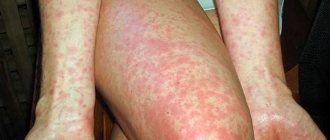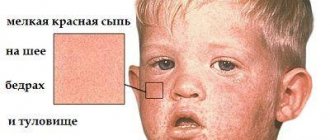What kind of “beast” is scarlet fever?
Scarlet fever is an acute infectious disease that occurs due to the activity of a microbe with the fancy name beta-hemolytic streptococcus. In addition to scarlet fever, it also causes a great many unpleasant sores of the throat - including all kinds of sore throats.
In essence, scarlet fever in children is a sore throat, only in an acute form and accompanied by a very specific rash.
The microbe beta-hemolytic streptococcus does not die at temperatures below 70°C, so even despite the sharp increase in body temperature during scarlet fever in children, the disease does not recede.
Scarlet fever is one of the extremely dangerous diseases, especially when it comes to children. Moreover, what is dangerous here is not the streptococcus microbe itself, but the substance erythrotoxin, which is produced by the microbe in the process of life. It is this toxin, spreading throughout the body through the bloodstream, that can cause severe damage to the heart, liver and kidneys. And it is erythrotoxin that is the main culprit in the appearance of the characteristic small rash with scarlet fever.
Latent period of the disease
The incubation period of childhood scarlet fever can last from several hours to 12 days, and during this period of time the infection only spreads throughout the body and does not make itself felt.
The duration of this period is determined by the state of the child’s health and immune system. With weak immunity, the child’s body cannot fight infection, and therefore the first signs of the disease begin to appear.
Scarlet fever during the latent period is also dangerous for others, as it is easily transmitted by airborne droplets and there is a risk of becoming infected even while in the same room with the patient.
Already a day before the appearance of primary symptoms. During the incubation period, the doctor most often prescribes a course of antibiotic treatment.
Scarlet fever in children: symptoms
The most characteristic symptoms of scarlet fever in children include:
- Fever (body temperature can “jump” to extreme values of 39.5 - 40°C);
- Headache;
- A specific small red rash that affects large areas of the body (but first the rash always appears in the throat - affecting the mucous membrane, without going beyond the surface of the tonsils and soft palate);
- Inflammatory processes in the throat (and, accordingly, pain and difficulty swallowing);
- Enlarged lymph nodes;
- Red “bumps” on the tongue (hypertrophied and brightly colored taste buds);
First of all, the disease affects the nasopharynx area, which means that symptoms of inflammation of the throat appear first. In general, at the initial stage, scarlet fever in children can be mistaken for an ordinary ARVI. Then a fever and obvious signs of a sore throat appear, and only after 1-2 days a specific rash on the skin appears (outwardly similar to intense urticaria).
With adequate treatment, the rash goes away quite quickly - usually within 5-6 days.
Symptoms of scarlet fever
The incubation period lasts on average 5-7 days (up to 12 days). The disease begins acutely. Body temperature rises to 39-40°C and higher, severe malaise, headache, pain when swallowing, often vomiting, sometimes delirium and convulsions appear. There is a burning sensation in the throat and it is difficult to swallow. The glands under the lower jaw become swollen, it hurts to open the mouth.
A typical and constant symptom is tonsillitis, characterized by a bright red color of the soft palate, enlarged tonsils, in the lacunae or on the surface of which plaque is often found. The upper cervical lymph nodes are enlarged and painful. Vomiting often occurs, sometimes repeatedly. There may be abdominal pain similar to appendicitis.
On the 1st, less often on the 2nd day, a bright pink or red pinpoint rash appears on the skin of the entire body in the form of overlapping red spots 1-2 mm in size protruding above the surface of the skin, which quickly grows throughout the body, resembling red goose bumps. The rashes are most intense in the area of the skin folds of the elbows and armpits. Scarlet fever is often accompanied by itching. The nasolabial triangle remains pale.
The face of the sick person is very different: a pink rash is on the forehead and temples, a bright blush appears on the cheeks, and the nose, upper lip and chin turn pale. When the nasolabial triangle is pale, the lips become brighter. The uvula, palatine arches, tonsils and palate turn bright red. Pustules or small areas of pus accumulation sometimes appear on the tonsils.
Scarlet fever is characterized by the proliferation and soreness of compacted maxillary lymph nodes; they are enlarged in size, elastic, and not connected to each other and the skin.
The rash lasts from 2 to 5 days, and then turns pale, while the body temperature drops. In the second week of illness, peeling of the skin appears. The tongue is initially coated, from the 2-3rd day it clears and by the 4th day it takes on a characteristic appearance: a bright red color, sharply protruding papillae (“crimson” tongue).
From the fifth to sixth day of the disease, peeling of the skin appears at the site of the rash, which lasts 2-3 weeks. Complications in the form of purulent inflammation of various organs are possible. After suffering from scarlet fever, some patients develop rheumatism.
The symptoms of scarlet fever largely coincide with the symptoms of a sore throat, so an accurate diagnosis is not always possible and an infected person can become a carrier of the virus.
Why and how children get scarlet fever
Scarlet fever is transmitted by airborne droplets. In fact, one sick child is capable of infecting the entire kindergarten class (or, if he is already a schoolchild, most of his classmates).
Through the upper respiratory tract, beta-hemolytic streptococcus enters the body, “settling” on the surface of the tonsils, where it begins to multiply, affecting the mucous membrane. However, not all children who “catch” the microbe necessarily develop scarlet fever. But only those who have not had it before, who have a weakened immune system, or those who have a predisposition.
Predisposition factors include:
- Chronic tonsillitis;
- Atopic dermatitis;
- Diathesis or other forms of skin rash;
- Pathologies of the endocrine system;
- Diseases of the nasopharynx - sinusitis, pharyngitis and others;
- Diseases causing immunodeficiency;
It is gratifying that a person can only have scarlet fever once in his life, after which he develops a strong immunity to this disease. In general, if you believe the statistics, then on average, out of 10 children infected with scarlet fever, only three actually get sick.
Scarlet fever is almost never diagnosed in children under one year of age. However, if this happens, the babies are placed in infectious diseases hospitals under constant observation - since at such a tender age, scarlet fever in children can behave very unpredictably.
The vast majority of children manage to get scarlet fever in kindergarten. A small percentage become ill in the lower grades of school, and it is extremely rare for children to grow into adolescence without ever “catching” scarlet fever in their lives.
Where can a child become infected with scarlet fever?
Scarlet fever is a highly contagious infection. Children 2-7 years old most often suffer from scarlet fever. Newborns (thanks to maternal immunity) rarely get scarlet fever. In adults, scarlet fever is milder than in children. Children become infected with scarlet fever mainly in kindergartens or schools. Several types of transmission of the scarlet fever pathogen are known: airborne (with inhaled air), contact (through contaminated things, toys), food (if food products, for example, milk, are contaminated with an aggressive microbe). Cases of scarlet fever localized to wounds are extremely rarely reported. In such cases, streptococcus settles and develops directly on the wound surfaces. In an epidemiological sense, however, the most important are the first two types of transmission of the scarlet fever pathogen, which contribute to the occurrence of scarlet fever epidemics in schools and preschool institutions.
Infection in children spreads primarily through airborne droplets, with the source being a sick person or a bacteria carrier. Less common are contact and household transmission (both direct and indirect contacts - through toys, care items, etc.) and food transmission - through infected products. The child is contagious from the 1st to the 22nd day of illness. Most often, scarlet fever occurs in the autumn-winter period.
The incubation period lasts 5-7 days (minimum several hours, maximum period up to 12 days). The latent period of scarlet fever lasts from 3 to 7 days. The disease begins acutely with a sharp disturbance in the child’s well-being: he becomes lethargic, drowsy, and complains of severe headache and chills. Body temperature quickly reaches high numbers (38-40 °C depending on the severity of the disease). Nausea and vomiting are often observed in the initial stages of the disease.
After a few hours, a specific rash appears on the child’s skin in the form of small bright pink dots on reddened skin. The rash is more pronounced on the face, lateral surfaces of the body and in places of natural skin folds (inguinal, axillary, buttock). A characteristic sign of scarlet fever is the sharp contrast between bright red “flaming” cheeks and a pale nasolabial triangle, on the skin of which there are no elements of the rash. The child’s appearance also attracts attention: in addition to the color contrast, his face is puffy, his eyes sparkle feverishly.
A typical and constant symptom is tonsillitis, characterized by bright redness of the soft palate, enlarged tonsils, in the lacunae or on the surface of which plaque is often found. The upper cervical lymph nodes are enlarged and painful. The rash stays on the skin for 3-7 days, after which it disappears, leaving no pigmentation behind. After 1-2 weeks, peeling begins, first on more delicate areas of the skin (neck, axillary folds, etc.), and then over the entire surface of the body. Scarlet fever is characterized by peeling on the palms and soles, which starts from the free edge of the nails and spreads along the fingers directly to the palms and soles, where the skin comes off in layers.
The tongue is initially coated, from the 2-3rd day it clears and by the 4th day it takes on a characteristic appearance: bright red color, sharply protruding papillae (“crimson” tongue). In the presence of severe intoxication, damage to the central nervous system is observed (excitement, delirium, blackout). At the beginning of the disease, there are symptoms of increased tone of the sympathetic, and from the 4-5th day - of the parasympathetic nervous system.
The disease can occur in mild, moderate and severe forms, depending on which the recovery time varies significantly (up to 3 weeks). Usually, the use of antibiotics allows for a faster recovery of the child’s health, and scarlet fever no longer poses a threat to his life. Complications of the disease are currently caused mainly by allergization of the body by beta-hemolytic streptococcus of group A, therefore they are noted in the 2nd week of the disease in the form of damage to the kidneys and heart. They usually occur in older children.
In mild forms of scarlet fever, intoxication is mild, fever and all other manifestations of the disease disappear by the 4-5th day; This is the most common variant of the modern course of scarlet fever. The moderate form is characterized by greater severity of all symptoms, including intoxication; the febrile period lasts 5-7 days. The severe form, currently very rare, occurs in two main variants: toxic scarlet fever with pronounced symptoms of intoxication (high fever, symptoms of central nervous system damage - blackouts, delirium, and in young children convulsions, meningeal signs), all symptoms from the pharynx and skin are clearly defined; severe septic scarlet fever with necrotizing tonsillitis, violent reaction of regional lymph nodes and frequent septic complications; necrosis in the pharynx can be located not only on the tonsils, but also on the mucous membrane of the soft palate and pharynx.
Complications: glomerulonephritis (mainly in the 3rd week), synovitis, the so-called infectious heart, less often myocarditis. Pneumonia is possible. Recurrences of scarlet fever and relapses of tonsillitis are associated with streptococcal reinfection. In recent decades, the incidence of complications has decreased sharply. After scarlet fever, lifelong immunity is usually maintained.
Treatment of scarlet fever in children
With adequate treatment, scarlet fever in children lasts about 20 days. As soon as the doctor confirms the diagnosis (with the help of external signs and special tests - clinical blood test, throat smear and others), he will prescribe antibacterial therapy.
The medicinal part of the treatment of scarlet fever in children (and in adults) must necessarily include the use of antibiotics such as penicillins. Otherwise, the disease is almost impossible to defeat. But remember that this or that type of antibiotic should be prescribed by a doctor, and not by a pharmacist at a pharmacy or you yourself. By neglecting qualified medical care in the treatment of scarlet fever, or refusing to use antibiotics, you essentially doom your child to the risk of acquiring extremely serious complications.
Despite the fact that antibiotics for scarlet fever in most cases very quickly alleviate the child’s condition, the prescribed course of taking the drug (usually up to 10 days) must be followed completely! Only in this case will the microbe be completely “defeated”, and will not remain “walking through the body”, being only “wounded”.
To reduce a child's fever, doctors usually prescribe paracetamol. In addition, when treating scarlet fever, it is useful to gargle regularly (you can just use water at room temperature, or you can add soda) and follow a drinking regime.
It's not the disease that's scary, it's its complications.
The peculiarity of beta-hemolytic streptococcus is that if the treatment of scarlet fever in children is carried out incorrectly (or not at all), this microbe can cause very serious complications on the heart, liver and kidneys of the child.
The most likely complications that may occur with scarlet fever:
- Cervical lymphadenitis and adenophlegmon (severe complications from the lymph nodes);
- Otitis;
- Pneumonia;
- Diffuse glomerulonephritis (severe kidney damage);
- Joint lesions (for example, articular rheumatism);
- Heart disease (for example, damage to the heart valves);
- Sydenham's chorea (brain damage);
Any of these complications can develop into severe pathology and even lead to death.
Until the world learned about the existence of antibiotics (the use of which now forms the basis of the treatment of scarlet fever in children), about half of all children with scarlet fever “recovered” with terrible pathologies of the heart, liver and kidneys - which is why scarlet fever was previously considered a deadly disease .
Symptoms, disease classification, complications
Scarlet fever occurs in stages
- The incubation stage lasts from several days to a week. The baby has a slight increase in temperature, weakness, fatigue, and in general, symptoms similar to ARVI.
- The initial stage is a clear manifestation of tonsillitis: the tonsils are red and enlarged, covered with a small rash, the papillae on the tongue are also enlarged, and high body temperature. We can say that these are the first signs that most likely indicate scarlet fever in a child.
- The rash stage is the result of the action of an exotoxin produced by streptococcus; the rash appears 1-2 days after the onset of sore throat. In addition to the rash, an elevated body temperature persists, and intoxication of the body begins, which is manifested by headache, nausea and vomiting. The rash of scarlet fever in children covers the entire body, especially pronounced in the lower abdomen, on the folds of the arms and legs, armpits, and on the sides of the torso. The skin color is red, but with clearly visible dark red small dots. The face with scarlet fever is always covered with a rash : the cheeks are bright red, the nasolabial triangle is white, free of rash. The tongue is crimson, the papillae of the tongue are greatly enlarged. The tonsils are very red, like a sore throat, often with a purulent coating. The skin is very dry and hot; If you run your finger over it, it will leave a bright white mark, which will then turn red again. The rash is accompanied by a very high temperature (39° and above) , which is difficult to control with antipyretics.
During the entire rash stage plus 5 days, the baby is extremely contagious and should be isolated from other children.
- The recovery stage is a time of attenuation of bright symptoms, however, treatment cannot be stopped: antibiotics are taken in a course for a strictly defined time.
You need to start treating scarlet fever as early as possible; be attentive to its symptoms in children. The tongue with scarlet fever in children clearly indicates the disease, see exactly how in the photo:
According to the severity of scarlet fever, the following forms are distinguished:
- mild: the course is mild or moderate, symptoms are mild, no complications arise;
- moderate: symptoms are moderate, the course of the disease is manageable, a favorable prognosis with timely treatment;
- severe: the symptoms are vivid, difficult to correct, and are accompanied by complications.
Scarlet fever in children, which has symptoms of mild and moderate forms of the disease, does not require hospitalization; treatment is carried out at home.
Possible complications
If timely treatment with antibiotics is started and the full course is completed, then the prognosis for the disease is favorable. However, if the signs of scarlet fever in children are left without attention and timely treatment, there is a high risk of developing complications:
- lymphadenitis (inflammation of the lymph nodes);
- purulent otitis;
- arthritis (inflammation of the joints);
- pneumonia;
- allergic myocarditis (heart dysfunction);
- glomerulonephritis (kidney damage).
Upon recovery after taking a full course of antibiotics, the baby develops lifelong immunity against scarlet fever. However, he will suffer from other diseases caused by strains of streptococcus.
Prevention of scarlet fever in children
Alas, the most important weapon for preventing any serious infectious disease, namely a vaccine, has not yet been invented against scarlet fever. This means that measures to prevent scarlet fever in children come down to adequate behavior, compliance with the “laws” of hygiene and timely consultation with a doctor if alarming symptoms are detected.
If in the children's group that your child attends, one of their peers is diagnosed with scarlet fever, honestly follow the quarantine rules (which the institution's health worker will instruct you about).
And besides, do not allow your child to develop protracted forms of any ENT diseases.
What complications can there be in children after scarlet fever?
If a child gets scarlet fever and the pathology progresses, the following consequences are possible:
- damage to the lymph nodes;
- severe inflammation of the ear, otitis media, often purulent;
- allergic kidney disease - glomerulonephritis;
- possible disturbances in the functioning of the heart;
- joint damage;
- pneumonia.
Complications and consequences of scarlet fever in children
Continuous treatment, taking antibiotics, and full compliance with the doctor’s recommendations will help to avoid complications. After a child recovers from scarlet fever, immunity to pathogens remains for the rest of his life. Re-infection is possible in isolated cases. Doctors believe that this is due to a very quick cure, when the disease can be dealt with urgently. In this case, immunity to the pathogen does not have time to form.











